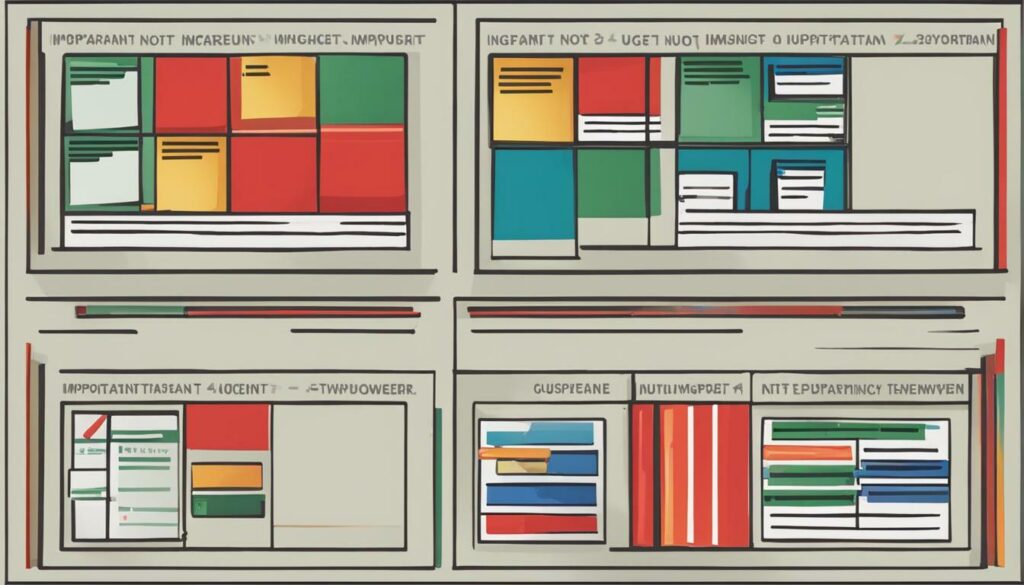What are time management best practices? We hear about it all the time. Did you ever get told in school, you have to manage your time better? How do we know what we don’t know about managing our time?
Effective time management is the key to unlocking your productivity potential and achieving your goals. By implementing proven time management strategies, you can prioritize tasks, reduce stress, and create more time for the things that truly matter. In this article, we will explore the best practices for managing your time efficiently and boosting your productivity.
Key Takeaways: Time Management Best Practices
- Prioritize tasks using techniques like the Eisenhower Matrix.
- Chunk your time into manageable intervals with the Pomodoro Technique.
- Focus on one task at a time to maximize productivity.
- Use rewards and goal-setting to stay motivated.
- Create an environment that supports efficient time management.
The Importance of Effective Time Management
Efficient time management is the key to maximizing productivity and achieving your goals. By organizing and prioritizing tasks effectively, you can reduce stress, have more time for activities that matter, and create a better work-life balance. Developing strong organizational skills is essential for effective time management, as it helps you stay focused and accomplish tasks efficiently.
“Time management is really about managing yourself. It’s about making conscious choices to allocate your time and energy in a way that aligns with your priorities and values.”
The Eisenhower Matrix is a powerful technique that helps individuals prioritize tasks based on their urgency and importance. By categorizing tasks into four quadrants – urgent and important, not urgent but important, urgent but not important, and not urgent nor important – you can allocate your time and effort more effectively. This method allows you to identify and focus on high-priority tasks, ensuring better time utilization and increased productivity.
| Urgent and Important | Not Urgent but Important |
|---|---|
| Deadline-driven tasks | Long-term goals |
| Emergencies | Strategic planning |
| Urgent but Not Important | Not Urgent nor Important |
|---|---|
| Interruptions | Time-wasting activities |
| Inefficient meetings | Distractions |
Another effective time management method is the Pomodoro Technique. This technique involves breaking work into focused intervals, typically 25 minutes of work followed by a 5-minute break. After completing four work intervals, take a longer break of approximately 15-30 minutes. This method helps improve concentration and prevents burnout, allowing you to maintain productivity throughout the day.
Tips for Effective Time Management
- Focus on one task at a time to avoid distractions and improve efficiency.
- Use rewards to motivate yourself and stay committed to your goals.
- Create a conducive environment by minimizing distractions and optimizing your workspace.
- Build good habits that support efficient time management, such as setting clear goals and establishing a routine.
- Perform a time audit to identify time-wasting activities and make necessary adjustments.
- Create a stop-doing list to eliminate non-essential tasks and commitments, freeing up time for more important activities.
Developing time management skills requires practice and reflection. By increasing your awareness of how you spend your time, arranging tasks and schedules effectively, and adapting to changes, you can enhance your ability to manage time efficiently. With the right strategies and skills in place, you can unlock your productivity potential and achieve a fulfilling work-life balance.

Prioritizing Tasks: The Eisenhower Matrix
When it comes to managing your time effectively, prioritizing tasks is key. One highly effective technique that can help you prioritize effectively is the Eisenhower Matrix. This matrix categorizes tasks into four quadrants based on their urgency and importance. By using this technique, you can ensure that you focus your time and energy on the tasks that truly matter.
The Eisenhower Matrix is a simple yet powerful tool that can help you make informed decisions about how to allocate your time. Here’s how it works:
- Quadrant 1: Urgent and Important: These are tasks that require immediate attention and have a significant impact on your goals and responsibilities. They should be your top priority and should be completed as soon as possible. Think of them as the “must-do” tasks.
- Quadrant 2: Important but Not Urgent: These tasks have a long-term impact on your goals and contribute to your personal and professional growth. They require planning and proactive action. Allocate dedicated time to these tasks to ensure they are completed effectively.
- Quadrant 3: Urgent but Not Important: Tasks in this quadrant are often distractions and interruptions that do not contribute significantly to your goals. They may require immediate attention, but they can be delegated or eliminated if they don’t align with your priorities.
- Quadrant 4: Not Urgent and Not Important: These tasks are time-wasters and distractions that should be minimized or eliminated altogether. They provide little value and can consume precious time that could be better spent on more important tasks.
By applying the Eisenhower Matrix, you can gain clarity on your priorities and make conscious decisions about how to spend your time. It helps you avoid the trap of constantly reacting to urgent but unimportant tasks and enables you to focus on what truly matters. Remember, effective time management is not just about getting things done; it’s about getting the right things done.
Example of the Eisenhower Matrix
| Quadrant | Urgent | Not Urgent |
|---|---|---|
| Important | Deadline for the upcoming project | Scheduling regular exercise |
| Not Important | Unnecessary meetings | Scrolling through social media |
As you can see in the example above, tasks like meeting deadlines and scheduling exercise fall into the important quadrant, while unnecessary meetings and social media scrolling fall into the not important quadrant. By categorizing your tasks in this way, you can easily identify what needs to be addressed immediately and what can be delegated or eliminated.
Implementing the Eisenhower Matrix can empower you to take control of your time and make better decisions about how to invest it. By focusing on what truly matters, you can boost your productivity, reduce stress, and achieve your goals more efficiently.

Chunking Time: The Pomodoro Technique
When it comes to maximizing productivity and managing your time effectively, one technique that has gained popularity is the Pomodoro Technique. This time management strategy involves breaking your work into focused intervals, typically 25 minutes in length, known as “pomodoros”. After each pomodoro, you take a short break, usually around 5 minutes, to recharge before diving back into the next pomodoro.
By chunking your time into these manageable intervals, you create a sense of urgency and focus, which can significantly enhance your productivity. The Pomodoro Technique helps combat distractions and prevents burnout by allowing regular breaks, promoting mental clarity and better task management.
Here is a simple breakdown of how the Pomodoro Technique works:
- Choose a task you want to work on.
- Set a timer for 25 minutes, and commit to working solely on that task.
- When the timer goes off, take a 5-minute break.
- Repeat the process, completing four pomodoros, and then take a longer break of around 15-30 minutes.
The Pomodoro Technique can be a game-changer for improving your time management skills. By setting clear boundaries and focusing on one task at a time, you train your brain to work efficiently and avoid burnout. Remember, constant practice and adaptation are key to making this technique work for you. So give it a try and unlock your productivity potential!
Pomodoro Technique Example
| Pomodoro | Duration | Break |
|---|---|---|
| Pomodoro 1 | 25 minutes | 5 minutes |
| Pomodoro 2 | 25 minutes | 5 minutes |
| Pomodoro 3 | 25 minutes | 5 minutes |
| Pomodoro 4 | 25 minutes | 5 minutes |
| Long Break | 15-30 minutes | N/A |

Focus on One Task at a Time
To effectively manage your time, it is essential to focus on one task at a time. Multitasking may seem like a productive approach, but it can actually hinder your efficiency and effectiveness. By concentrating on one task, you can give it your undivided attention and complete it to the best of your abilities.
Research has shown that trying to juggle multiple tasks simultaneously can lead to increased stress levels and a decrease in overall productivity. When you divide your attention among various tasks, you may find yourself making more mistakes and taking longer to complete each task.
To stay focused on one task, eliminate distractions from your environment. Close unnecessary tabs on your computer, put your phone on silent, and create a dedicated workspace free from disruptions. It is also helpful to break your tasks into smaller, manageable chunks. By setting realistic goals for each chunk and giving yourself specific timeframes, you can stay focused and motivated.
Remember, when you focus on one task at a time, you are giving it the attention it deserves. This allows you to work more efficiently and produce higher-quality results.
By honing your time management skills and practicing the art of single-tasking, you will not only improve your productivity but also reduce stress and increase your overall sense of accomplishment. Give yourself permission to dedicate your full attention to one task and watch as your efficiency and productivity soar.

| Benefits of Focusing on One Task at a Time |
|---|
| Enhanced concentration |
| Increased productivity |
| Improved quality of work |
| Reduced stress levels |
| Greater sense of accomplishment |
Using Rewards to Motivate Yourself
When it comes to effective time management strategies, finding ways to stay motivated is essential. One powerful technique is using rewards to incentivize yourself and keep your productivity levels high. By setting goals and attaching rewards to their completion, you can create a sense of excitement and anticipation that drives you to manage your time more efficiently.
Goal setting is an important aspect of time management. By defining clear objectives, you give yourself something to strive for and measure your progress against. Whether it’s completing a project, reaching a milestone, or mastering a new skill, goals provide a sense of purpose and direction. But goals alone may not always be enough to keep you motivated throughout the journey.
That’s where rewards come in. By establishing small, meaningful rewards for yourself as you make progress towards your goals, you create a positive feedback loop that fuels your motivation. These rewards can be anything that brings you joy and serves as a little treat for your hard work. It could be taking a short break to enjoy a cup of coffee, treating yourself to a favorite snack, or indulging in a hobby or activity that brings you happiness.

Remember to choose rewards that align with your values and priorities. They should be in line with the effort and progress you’re making, and they should reinforce positive habits and behaviors. By incorporating rewards into your time management approach, you create a sense of personal satisfaction and accomplishment that inspires you to continue managing your time effectively.
Key Takeaways:
- Setting goals and attaching rewards to their completion can significantly boost your motivation in managing your time effectively.
- Goals provide a sense of purpose and direction, while rewards create positive reinforcement and excitement along the way.
- Choose rewards that align with your values and priorities and that provide a sense of personal satisfaction and accomplishment.
| Benefits of Using Rewards in Time Management: | Examples of Rewards: |
|---|---|
| Increased motivation: Rewards serve as incentives to stay focused and complete tasks efficiently. | Short breaks: Enjoying a cup of coffee, going for a walk, or meditating. |
| Positive reinforcement: Rewards reinforce habits and behaviors that lead to better time management. | Treats: Indulging in a favorite snack, dessert, or meal. |
| Enhanced satisfaction: Achieving goals and receiving rewards create a sense of accomplishment and fulfillment. | Hobbies and leisure activities: Engaging in activities like reading, painting, or playing a musical instrument. |
Creating the Right Environment for Efficient Time Management
Creating the right environment is an essential aspect of efficient time management. By optimizing your workspace and minimizing distractions, you can enhance your focus and productivity. A clutter-free and organized workspace promotes a clear mind and allows you to work more effectively.
Consider setting up a dedicated workspace that is separate from your personal space. This can be a specific room or even just a designated area in your home. By having a dedicated workspace, you can mentally associate that area with work and enter a focused mindset when you’re there.
Additionally, keep your workspace organized by decluttering regularly. Remove any unnecessary items or distractions that may divert your attention. Having everything in its place and a clean workspace can reduce mental clutter and help you stay focused on the task at hand.
| Benefits of Creating the Right Environment |
|---|
| Minimizes distractions and interruptions |
| Promotes focus and concentration |
| Creates a conducive atmosphere for optimal productivity |
| Reduces stress and mental clutter |
“Your environment affects your ability to stay focused. Create a workspace that inspires you and helps you stay on track.”
Additionally, consider the impact of digital distractions on your productivity. Notifications from social media, emails, and other online platforms can disrupt your workflow and make it challenging to manage time effectively. To combat this, set boundaries by silencing notifications during designated work periods and using website blockers or productivity apps to limit time spent on non-work-related websites.
Remember, the environment you create for yourself has a significant impact on your ability to manage time efficiently. Take the time to optimize your workspace, remove distractions, and create a focused atmosphere. By doing so, you’ll set yourself up for success and unlock your productivity potential.

Building Good Habits
Developing good habits is a key aspect of effective time management. When you establish positive routines, you can streamline your tasks, eliminate unnecessary decision-making, and optimize your productivity. Building good habits requires discipline and consistency, but the long-term benefits are worth the effort.
One of the most effective ways to build good habits is to start small. Break down your goals into smaller, achievable tasks that you can incorporate into your daily routine. By focusing on one habit at a time, you can give it the attention and effort it deserves. As the saying goes, “Rome wasn’t built in a day.” Similarly, building good habits takes time and patience.
“Successful people are simply those with successful habits.” – Brian Tracy
Another important aspect of building good habits is accountability. Find ways to hold yourself accountable for sticking to your new habits. This could be by sharing your goals with a friend or family member, using a habit-tracking app, or even rewarding yourself when you successfully follow through. By creating a system of checks and balances, you can increase your chances of building long-lasting habits.
Table: Example Habit-Building Steps
| Habit | Steps |
|---|---|
| Waking up early |
|
| Daily exercise |
|
| Time-blocking |
|
Lastly, be kind to yourself when building new habits. It’s normal to experience setbacks or moments of inconsistency. Instead of letting these moments discourage you, use them as learning opportunities and adjust your approach if needed. Remember, building good habits is a journey, and every step forward counts.

Performing a Time Audit
When it comes to effective time management, understanding how you currently spend your time is crucial. Performing a time audit allows you to gain insight into your daily activities, identify time-wasting habits, and make necessary changes to improve productivity. Here are the steps to conduct a time audit:
Create a log:
Start by keeping a log of your activities for a certain period, such as a week. Note down every task you perform and the time spent on each. Be as detailed as possible to have an accurate representation of your daily routine.
Analyze your patterns:
Once you have gathered enough data, analyze your patterns and habits. Look for any recurring tasks that consume a significant amount of time. Pay attention to activities that are not contributing to your goals or overall well-being.
Identify time-wasters:
During the analysis, identify any time-wasting activities or distractions that hinder your productivity. These may include excessive social media usage, unnecessary meetings, or spending time on low-priority tasks.
Make changes:
Based on the insights gained from your time audit, make the necessary changes to your routine. Eliminate or delegate tasks that add little value to your goals. Allocate more time to high-priority activities and ensure you have breaks scheduled to rest and recharge.
Example Time Audit Log:
| Activity | Time Spent |
|---|---|
| Checking emails | 30 minutes |
| Responding to emails | 45 minutes |
| Attending meetings | 2 hours |
| Scrolling through social media | 1 hour |
| Working on a high-priority project | 3 hours |
By performing a time audit and making necessary adjustments to your routine, you can optimize your time management skills and achieve greater efficiency. Remember to regularly reassess your activities and adapt to changes in your goals and priorities. With practice and reflection, you can master the art of managing your time effectively and unlock your full productivity potential.

Creating a Stop-Doing List
When it comes to effective time management strategies, it’s not just about what you do, but also what you stop doing. We often find ourselves overwhelmed by a never-ending to-do list, filled with tasks that may not be essential or align with our goals. That’s where creating a stop-doing list can be a game-changer. It’s a simple yet powerful technique for decluttering your schedule and freeing up valuable time.
To create a stop-doing list, start by reflecting on your current commitments and activities. Identify tasks that are non-essential, time-consuming, or no longer aligned with your goals. These could be activities that drain your energy or prevent you from focusing on what truly matters. Once you have a list of these tasks, make a conscious decision to stop doing them.
By eliminating non-essential tasks, you create space for activities that truly contribute to your success and well-being. You’ll feel a sense of liberation and experience a boost in productivity. Remember, it’s not about doing more; it’s about doing the right things. Your stop-doing list will help you prioritize and streamline your efforts, allowing you to focus on what truly matters and bring about meaningful results.
Creating a stop-doing list requires discipline and commitment, but the rewards are worth it. You’ll gain control over your time, reduce stress, and create more opportunities for growth and fulfillment. So take a step back, evaluate your commitments, and start freeing yourself from unnecessary tasks. Embrace the power of saying no to what no longer serves you, and watch as your productivity soars and your life becomes more balanced and fulfilling.
FAQ: Time Management Best Practices
Q: Why is time management important for productivity?
A: Effective time management allows individuals to prioritize tasks, reduce stress, and have more time for meaningful activities, ultimately maximizing productivity and achieving goals.
Q: What are some important time management strategies?
A: Some important time management strategies include prioritizing tasks using techniques like the Eisenhower Matrix, chunking time into manageable intervals with methods like the Pomodoro Technique, focusing on one task at a time, and using rewards to motivate yourself.
Q: How can I create the right environment for effective time management?
A: Creating the right environment involves minimizing distractions and optimizing your workspace to enhance focus and productivity. Taking steps like organizing your physical and digital space can contribute to efficient time management.
Q: How can I build good habits to support time management?
A: Building good habits involves cultivating routines and behaviors that support efficient time management. This can include setting daily schedules, prioritizing tasks, and practicing discipline and consistency in your daily routine.
Q: What is a time audit and how can it improve time management?
A: A time audit involves tracking how you spend your time to identify time-wasting activities and areas for improvement. By analyzing the results of a time audit, you can make adjustments and better allocate your time towards tasks that contribute to your goals and overall productivity.
Q: How can I create a stop-doing list to improve time management?
A: Creating a stop-doing list involves identifying non-essential tasks and commitments that can be eliminated or delegated. By decluttering your schedule and focusing on high-priority tasks, you can free up time and enhance your time management efforts.
Source Links
- https://www.educative.io/blog/effective-time-management-techniques
- https://www.coursera.org/articles/time-management
- https://www.betterup.com/blog/time-management
Personal Development Unlimited is your go-to place to be You, Without Limits. We bring together personal development and self-improvement articles, books, courses and videos in one place. Find your self-growth opportunities easily.
Comments
0 comments



